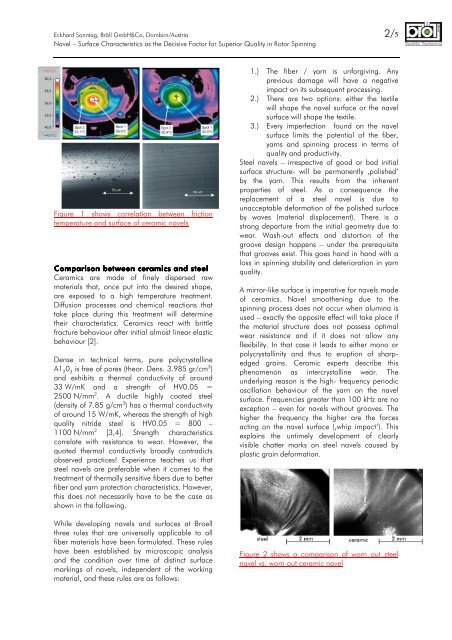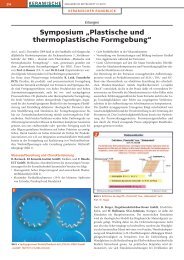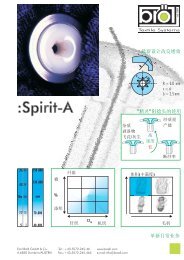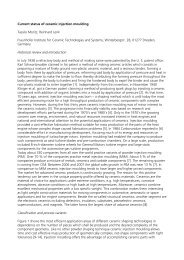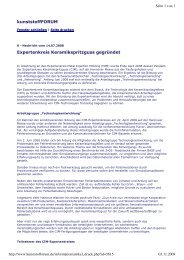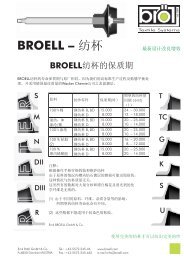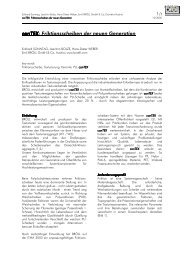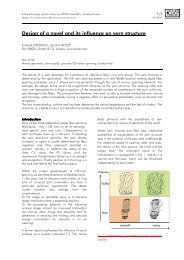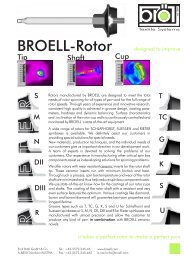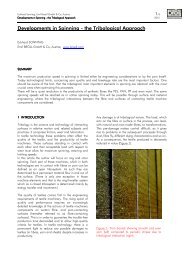Ad1-Internetartikel english
Ad1-Internetartikel english
Ad1-Internetartikel english
You also want an ePaper? Increase the reach of your titles
YUMPU automatically turns print PDFs into web optimized ePapers that Google loves.
Eckhard Sonntag, Bröll GmbH&Co, Dornbirn/Austria 2/5<br />
Navel – Surface Characteristics as the Decisive Factor for Superior Quality in Rotor Spinning<br />
Figure 1 shows correlation between friction<br />
temperature and surface of ceramic navels<br />
Comparison Comparison between between between ceramics ceramics ceramics and and steel steel<br />
steel<br />
Ceramics are made of finely dispersed raw<br />
materials that, once put into the desired shape,<br />
are exposed to a high temperature treatment.<br />
Diffusion processes and chemical reactions that<br />
take place during this treatment will determine<br />
their characteristics. Ceramics react with brittle<br />
fracture behaviour after initial almost linear elastic<br />
behaviour [2].<br />
Dense in technical terms, pure polycrystalline<br />
A1 2 0 3 is free of pores (theor. Dens. 3.985 gr/cm 3 )<br />
and exhibits a thermal conductivity of around<br />
33 W/mK and a strength of HV0.05 =<br />
2500 N/mm 2 . A ductile highly coated steel<br />
(density of 7.85 g/cm 3 ) has a thermal conductivity<br />
of around 15 W/mK, whereas the strength of high<br />
quality nitride steel is HV0.05 = 800 –<br />
1100 N/mm 2 [3,4]. Strength characteristics<br />
correlate with resistance to wear. However, the<br />
quoted thermal conductivity broadly contradicts<br />
observed practices! Experience teaches us that<br />
steel navels are preferable when it comes to the<br />
treatment of thermally sensitive fibers due to better<br />
fiber and yarn protection characteristics. However,<br />
this does not necessarily have to be the case as<br />
shown in the following.<br />
While developing navels and surfaces at Broell<br />
three rules that are universally applicable to all<br />
fiber materials have been formulated. These rules<br />
have been established by microscopic analysis<br />
and the condition over time of distinct surface<br />
markings of navels, independent of the working<br />
material, and these rules are as follows:<br />
1.) The fiber / yarn is unforgiving. Any<br />
previous damage will have a negative<br />
impact on its subsequent processing.<br />
2.) There are two options: either the textile<br />
will shape the navel surface or the navel<br />
surface will shape the textile.<br />
3.) Every imperfection found on the navel<br />
surface limits the potential of the fiber,<br />
yarns and spinning process in terms of<br />
quality and productivity.<br />
Steel navels – irrespective of good or bad initial<br />
surface structure- will be permanently ‚polished‘<br />
by the yarn. This results from the inherent<br />
properties of steel. As a consequence the<br />
replacement of a steel navel is due to<br />
unacceptable deformation of the polished surface<br />
by waves (material displacement). There is a<br />
strong departure from the initial geometry due to<br />
wear. Wash-out effects and distortion of the<br />
groove design happens – under the prerequisite<br />
that grooves exist. This goes hand in hand with a<br />
loss in spinning stability and deterioration in yarn<br />
quality.<br />
A mirror-like surface is imperative for navels made<br />
of ceramics. Navel smoothening due to the<br />
spinning process does not occur when alumina is<br />
used – exactly the opposite effect will take place if<br />
the material structure does not possess optimal<br />
wear resistance and if it does not allow any<br />
flexibility. In that case it leads to either mono or<br />
polycrystallinity and thus to eruption of sharpedged<br />
grains. Ceramic experts describe this<br />
phenomenon as intercrystalline wear. The<br />
underlying reason is the high- frequency periodic<br />
oscillation behaviour of the yarn on the navel<br />
surface. Frequencies greater than 100 kHz are no<br />
exception – even for navels without grooves. The<br />
higher the frequency the higher are the forces<br />
acting on the navel surface (‚whip impact‘). This<br />
explains the untimely development of clearly<br />
visible chatter marks on steel navels caused by<br />
plastic grain deformation.<br />
Figure 2 shows a comparison of worn out steel<br />
navel vs. worn out ceramic navel<br />
Emil Emil Bröll Bröll GmbH GmbH GmbH &<br />
&<br />
Co. Co. Holzstr.1 D-<br />
73650 Winterbach


